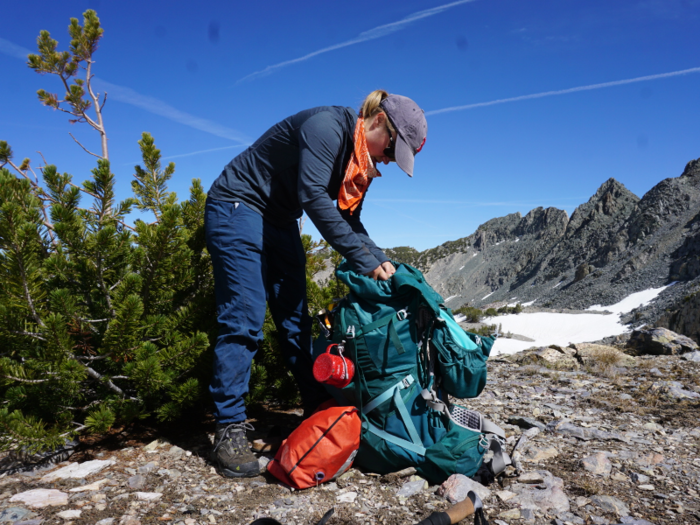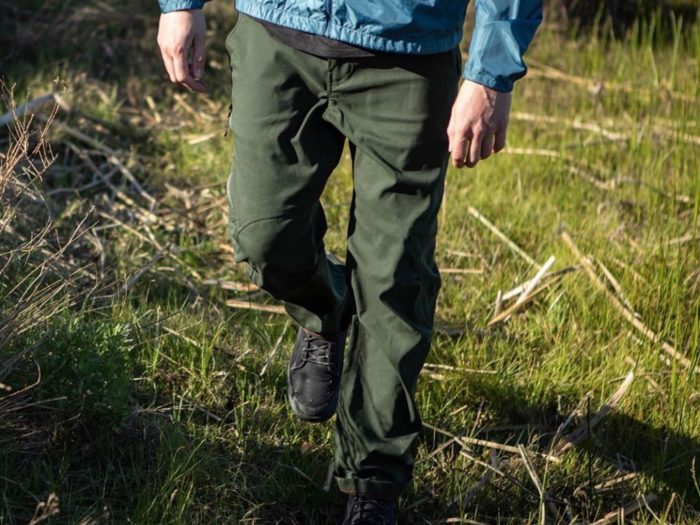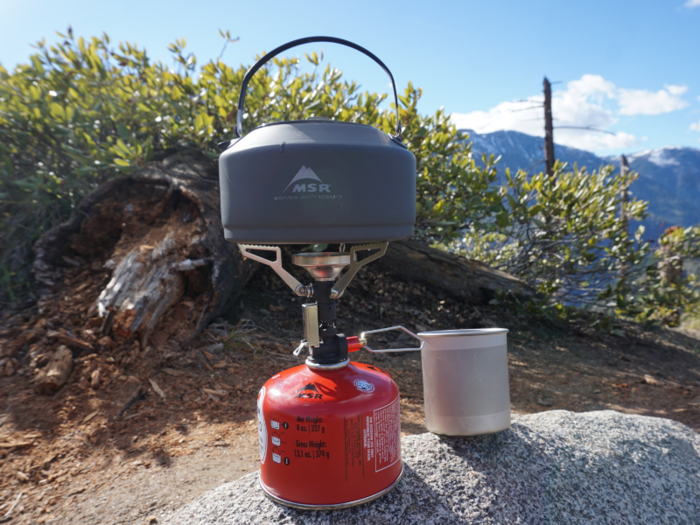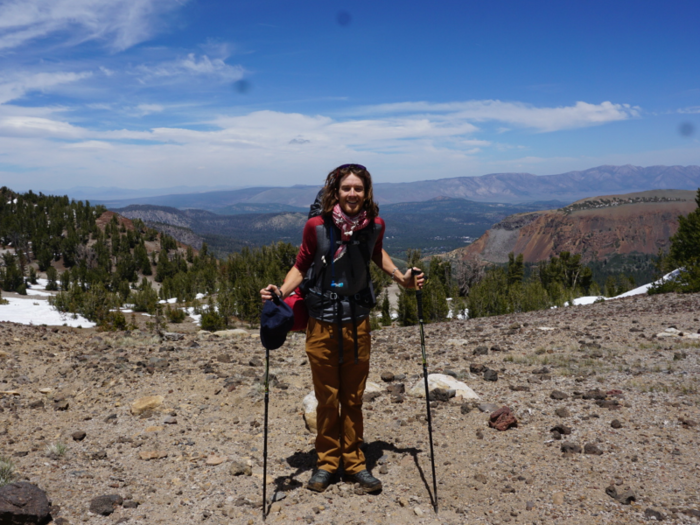- Home
- slideshows
- miscellaneous
- How to plan your first backpacking trip and everything you need to bring with you
How to plan your first backpacking trip and everything you need to bring with you
How to plan your route

Backpacking safety tips

In all likelihood, this part of the plan will take the most time and won't really be much use, but having a plan is always a good idea.
- Have bailout points. If the hike gets too hard or you get hurt, look for ways to hike to a road. Worst case, you can stick out your thumb in most national parks and find someone who knows exactly how you feel and is willing to help. I've done it more than once.
- Share your plan with someone. Let them know where you'll be, call them when you leave, and call them when you return. Set a time for your expected return and a time by which you want them to alert authorities if you haven't made it. This sounds severe but it takes minutes and saves lives. Here, I have even written a script for you so you have no excuse not to copy and paste this into an email. "Hey Friend, I am hiking this route (include a link or a description) and I hope to be done by 5 p.m. on Sunday. I'll text you when I set off and if you don't hear from me by 8 p.m., please alert mountain rescue at this number."
- Check out the local conditions. If it's summer in California, then don't be lighting a fire, as you might start a wildfire. If you're in bear country, then research how to be bear safe. If there's a risk of avalanches or lightning or flash flooding, know what to do. You might need to carry a water filter if there isn't safe water. All of these things are perfectly survivable if you spend half an hour online reading the relevant advice from your friendly local public lands management agency.
- Bring a GPS and a satellite communicator. Personally, I like to carry a Spot satellite communicator and GPS mapping device so I can call for help and find my way. It's got me out of a lot of fixes including some that really could have been quite serious. I have never pressed the SOS button, but it's nice to know I could. Also, even when I don't, I like to check in on family with a short message. You don't need fancy tech, a map and a compass should help you find your way out of any fix if you know how to use them (REI offers classes). I pack a first-aid kit as well. Again, this is useless without knowing how to use it.
- You can take your phone if you want, and sometimes I used to take mine, but I have found it stops me really being in the moment outside. I like to read at night and check in at home, but I don't need to know how many likes my cat photo has on Instagram. I prefer to take a book or a Kindle and a simple messaging device to cut down on tech distraction on the trail.
Bring a good tent, sleeping pad, and sleeping bag

Sleeping gear will be the biggest addition to your hiking pack. You need a place to sleep and a way to stay warm. It's fine to borrow gear until you know what you want. My suggestions below are what I use on overnight and multi-day hikes, but borrowing or renting gear is a great way to start.
TentThis is a good place to save weight. I prefer a freestanding tent for its versatility and ease of pitching. You should plan to purchase a two-person tent so you have enough space. They are nowhere near twice the cost of single-person tents nor are they double the weight. My pick is the MSR Hubba Tour for two people. It's spacious, not too heavy, and has a huge vestibule area for storing your gear.
Buy the MSR Hubba Tour 2 Tent for $649.95 on REI Sleep systemThis consists of a pad, bag, or quilt, and maybe a pillow. Again, you can save weight here. Some ultralight types will opt for a half-length sleeping pad that only pads your torso, but with products like Therm-a-Rest's Neoair uberlite, you can sleep in comfort without much of a weight penalty.
Recently, I have been really enjoying quilt camping. A sleeping bag doesn't insulate you from the bottom much, because you squash the insulation. Your pad keeps you warm from below. For me, the grapefruit-sized Therm-a-Rest Vesper is a great choice for quilt camping. For a more affordable set up the classic Therm-a-Rest Z Lite is great value, as is the roomy and comfy Nemo Forte bag.
Buy the Therm-a-Rest NeoAir Sleeping Pad from $139.95 at REI Buy the Therm-a-Rest Vesper Down Quilt from $319.95 at REI Buy the Therm-a-Rest Z Lite Sol Sleeping Pad from $34.95 at REI Buy the Nemo Forte 20 Sleeping Bag from $189.95 at REIBring a good hiking backpack

You're going to need a way to carry all this gear, and that is where a backpack comes in. This isn't a place to save weight. Even if you want to go super light, go ahead and cut down your toothbrush but buy a pack that fits and works for you. I'd suggest trying out several packs and opting for one that fits your torso, experts at outdoor shops can really help here.
Once you have your pack or have one to borrow, make sure to try some day hikes with 30 pounds of weight in it to be sure it doesn't rub or pinch you. Don't opt for something enormous, either. You'll fill that space with stuff you think you'll need, and then you'll use it because you have it.
A 45-liter pack is plenty big enough for a few nights on the trail. Years ago, I would carry a 65-liter behemoth of a bag and wonder why my knees hurt. These days I reserve that bag for packrafting trips because there is literally enough space for all my stuff and an entire boat, paddle, life jacket, and drysuit in it.
My go-to is the Gregory Optic 48, while my wife prefers the Osprey Aura 50. Backpacks are one of the few items where I'll suggest that you opt for a gender-specific fit. Women's hips are different and so their packs should be as well.
Buy the Gregory Optic 48 Pack for $189.95 at REI Buy the Osprey Aura AG 50 Pack for $240 at REIWear the right hiking boots or shoes

Stick with what works for you on day hikes. You don't need a super sturdy high ankle boot if that isn't what you prefer. Use what works for your feet.
I'm a massive fan of Vasque's lightweight Saga Gore Tex Boots. I have hiked in the snow in those boots, and I have used them in the desert, too. If shoes are more your thing, Danner's Trail 2650 Shoes look great, have plenty of support, and weigh a lot less than boots, helping to keep you nimble.
Buy the Vasque Saga GTX Hiking Boots for $174.93 at REI Buy the Danner Trail 2650 Hiking Shoes for $149.95 at REIBring the right clothing for the weather

Try and layer up as you would on a normal hike, but be sure to prepare for lower temps at night. I always pack my Rab Microlite puffy in addition to my hiking gear, and if it's really cold, I sleep in it as well.
You can get away with the same shirt and pants for two days, especially if you don't sleep in them. But a change of underwear and socks is vital. I always opt for merino wool on the trail, as its breathability and ability to suppress odors is unsurpassed.
Some current favorite trail items for me are the 686 anything pant, the Black Diamond Rhythm tee, and Smartwool's boxers and socks.
Buy the Rab Microlight Alpine Down Jacket for $280 at REI Buy the 686 Men's Anything Multi Cargo Pant for $109.95 at REI Buy the Black Diamond Rhythm T-Shirt for $51.93 at REI Buy the SmartWool Men's Merino 150 Boxer for $50 at REIBring lightweight cookware and food

Cooking is part of the fun of backpacking for me. For others, it's just something they need to do to get fuel back in. If you want to go stoveless and superlight, more power to you. But I'm not logging 20-mile days without hot coffee beforehand and a warm meal after.
I would suggest a lightweight gas stove to begin with, they are cheap, easy to use, and boil water really quickly. The MSR Pocket Rocket has been my faithful companion for years. Combine this with either ready-made meals — Good 2 Go are far and away the best I have tried — or make your own. Cous cous is a winner, as it doesn't need to be simmered so it uses less fuel to cook, and it weighs next to nothing.
Be sure to bring plenty of snacks as well, big bags and big miles will leave you with a hearty appetite. Bring a few of Sea to Summit's great silicone cups and plates to eat from, and of course, get yourself a spork.
Decathlon offers an excellent beginner cookset that includes everything you'll need in a compact package. I've found I can fit my stove and a towel for clean up and to stop rattling into the provided pot along with the included sporks and bowls.
Buy the MSR PocketRocket 2 Stove for $44.95 at REI Shop Good 2 Go meals from $6.50 at REI Shop Sea to Summit silicone cups and plates from $7.95 at REIYou may want to bring a few luxuries

We all have things we need to get us through the hard trail days. For me, it's pillows. I'll sleep on a Tyvek sheet on the ground in a bivvy bag for a week, but I need at least two pillows. I know people make do with a folded puffy or their clothes in a stuff sack, but if I don't sleep well, I don't have fun.
Some of my friends like headlamps for around camp at night or a small stool to sit on. You might want some poles for all that weight as well. I prefer Black Diamond's non-telescoping poles after breaking too many adjustable poles.
Your luxury might be different. Freshly ground coffee and a flask of whisky are some of my other favorites.
My wife likes bringing a Kindle or even a paper book. Whatever it is that makes your tent feel like home, put it in your bag and don't let any gram counters shame you for it.
Buy the Sea to Summit Aeros Ultralight Pillow from $39.95 at REI Buy the BioLite Headlamp 330 for $49.95 at REI Buy the Black Diamond Distance Z Trekking Poles for $99.95 at REIPopular Right Now
Popular Keywords
Advertisement